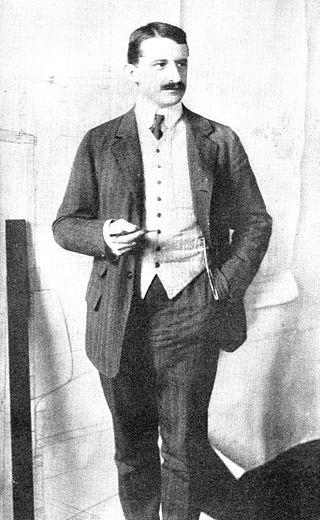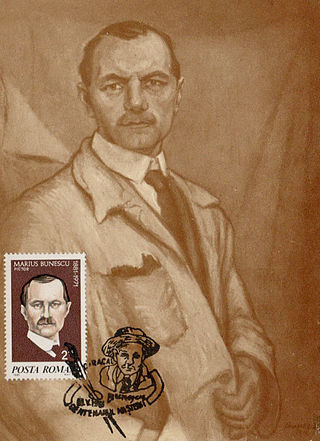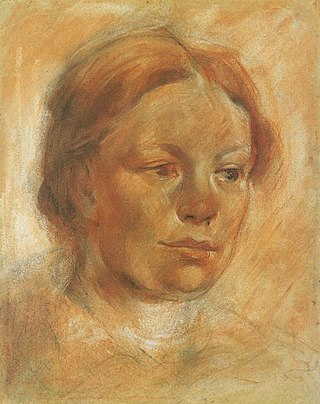
Paul Klee was a Swiss-born German artist. His highly individual style was influenced by movements in art that included expressionism, cubism, and surrealism. Klee was a natural draftsman who experimented with and eventually deeply explored color theory, writing about it extensively; his lectures Writings on Form and Design Theory, published in English as the Paul Klee Notebooks, are held to be as important for modern art as Leonardo da Vinci's A Treatise on Painting was for the Renaissance. He and his colleague, Russian painter Wassily Kandinsky, both taught at the Bauhaus school of art, design and architecture in Germany. His works reflect his dry humor and his sometimes childlike perspective, his personal moods and beliefs, and his musicality.

August Robert Ludwig Macke was a German Expressionist painter. He was one of the leading members of the German Expressionist group Der Blaue Reiter. He lived during a particularly active time for German art: he saw the development of the main German Expressionist movements as well as the arrival of the successive avant-garde movements which were forming in the rest of Europe. As an artist of his time, Macke knew how to integrate into his painting the elements of the avant-garde which most interested him. Like his friend Franz Marc and Otto Soltau, he was one of the young German artists who died in the First World War.

Peter von Cornelius was a German painter; one of the main representatives of the Nazarene movement. He was the uncle of the composer Peter Cornelius (1824–1874).

Franz Ritter von Stuck, born Franz Stuck, was a German painter, sculptor, printmaker, and architect. Stuck was best known for his paintings of ancient mythology, receiving substantial critical acclaim with The Sin in 1892. In 1906, Stuck was awarded the Order of Merit of the Bavarian Crown and was henceforth known as Ritter von Stuck.

The Academy of Fine Arts, Munich is one of the oldest and most significant art academies in Germany. It is located in the Maxvorstadt district of Munich, in Bavaria, Germany.

Adolf Ziegler was a German painter and politician. He was tasked by the Nazi Party to oversee the purging of what the Party described as "degenerate art", by most of the German modern artists. He was Hitler's favourite painter. He was born in Bremen and died in Varnhalt, today Baden-Baden.

Otto Müller was a German painter and printmaker of the Die Brücke expressionist movement.

Werner Peiner was a German painter. He was first influenced by realism, and later by New Objectivity, but he would become known as one of the most talented official painters of the Third Reich.

Conrad Hommel was a German painter. He was best known for his portraits of leading German entrepreneurs such as Max Grundig, Herbert Quandt, and politicians such as Adolf Hitler, Hermann Göring and Paul von Hindenburg.

The Lenbachhaus is a building housing the Städtische Galerie art museum in Munich's Kunstareal.

Bruno Paul was a German architect, illustrator, interior designer, and furniture designer.

Hermann Paul Maximilian Abendroth was a German conductor.

Marius Bunescu was a Romanian painter, organizer of the National Museum of Art, and director of the Anastase Simu Museum.

The Berlin Secession was an art movement established in Germany on May 2, 1898. Formed in reaction to the Association of Berlin Artists, and the restrictions on contemporary art imposed by Kaiser Wilhelm II, 65 artists "seceded," demonstrating against the standards of academic or government-endorsed art. The movement is classified as a form of German Modernism, and came on the heels of several other secessions in Germany, including Jugendstil and the Munich Secession.

Max Feldbauer (1869–1948) was a German painter, associated with the Munich Secession. He is primarily known for rural, Bavarian scenes.

Hermann von Wedderkop (1875–1956), also known as Weddo, was a German writer, translator and editor of the art magazine Der Querschnitt.

Albert Weisgerber was a German painter whose work forms a bridge between Impressionism and early Expressionism.

Oskar Wilhelm Lüthy was a Swiss painter of still lifes, landscapes and religious art. He co-founded Der Moderne Bund, a group of Swiss modernist artists.

Maria Franck-Marc, née Bertha Pauline Marie Franck, was a German artist. She is also known as the wife of the painter Franz Marc.
Groeber is a German surname. Notable people with the surname include:




















